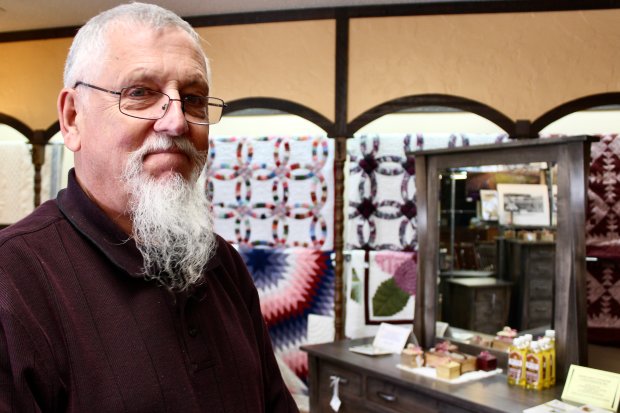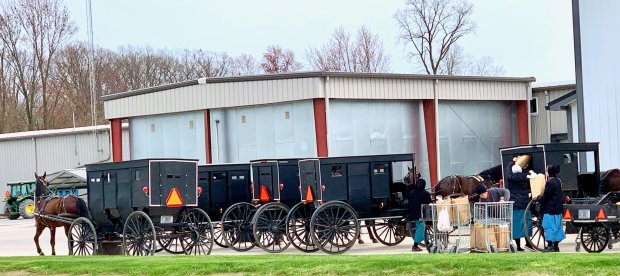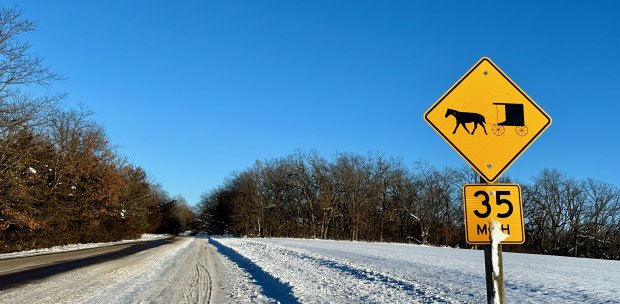When life feels too complicated, I can regain a sense of balance by driving to farmland where Amish families intentionally live quietly, simply and conservatively. Add “mysteriously,” if you’ve had little exposure to their lifestyle.
In their rural landscape are black, horse-drawn buggies instead of trucks and tractors. They are driven by men with straw hats, suspenders and beards. The women wear bonnets and modest, ankle-length dresses.
Roughly 384,300 Amish people live in 32 states and four provinces in North America, reports Elizabethtown College, where Amish studies is a specialty. The college is in Lancaster County, Pennsylvania, home to the nation’s largest Amish population at 44,315.
These Christian families typically live without electricity, motorized vehicles, telephones and other modern conveniences. Contact with outsiders is not a priority; but interactions are not one-dimensional, cookie-cutter experiences either.
Amish encounters, and how hard you have to work to find them, in part depend on location. Communities with a high concentration of Amish families approach tourism with varying degrees of interest, creativity and commercialism. Consider the examples of Wisconsin, Illinois and Indiana.
Wisconsin: root around on your own
My wintry Saturday drive ended 40 miles north of Madison as I cut east toward Dalton, population 203, for a glimpse and taste of Amish life. Thick-legged workhorses hauled ice from a pond. Others clip-clopped more daintily while pulling buggies on snow-packed hills.
Roughly 10% of Wisconsin’s 25,000 Amish residents live between Highways 22 and 73; Barry Road is one popular shopping route.
First stop, farm-based Pleasant View Bakery, south of Barry Road. In the commercial kitchen were pans of just-baked cinnamon rolls. Cherry mash — chocolate under and over a vanilla filling with chopped cherries — roused my curiosity; I bought one-half of the last pound and also left with a cherry pie, pumpkin bars and a dozen cookies.
Next, Mishler’s Country Store, where household provisions arrive in bulk and are packaged into portions suitable for the average family. Sets of wind chimes, made by the Amish in Indiana, tinkled outdoors. Fat heads of cauliflower, blemish-free and 89 cents each, filled a shopping cart indoors.
On a bulletin board were signs and business cards for clock repair, rides, welding, stump removal and more. On shelves were Amish cookbooks, home medicine remedies and seasoning blends that included ones for homemade bacon and bologna.
I left with cauliflower, a garlic bulb, bags of teeny bow-tie pasta and chopped pecans. Eggs were not in stock, but the clerk eagerly gave directions to a farm with chickens.
Last stop, Mast’s Bent and Dent, which stocks an unpredictable mix of nonperishable foods that are near, at, or past “best by” dates. Don’t expect signage; I drove past the farm-based business twice before nailing the location.
The treasure hunt of merchandise from overstocks and liquidations was excellent at this well-organized store. Vinaigrettes, toothpaste, mouth guards for sleep, Dolly Parton cake mixes, keto products and oodles of other items were deeply discounted.
Adding a stop or two for bedding plants would be logical during spring. There are at least a dozen greenhouses in the rural neighborhood. The countryside is similarly abundant with woodworkers who build kitchen cabinets, furniture, birdhouses and cutting boards — and they might sell items for Amish craftsmen from other states.
Businesses are listed by address at travelmarquettecounty.com. Or visit the Princeton Amish Country Store for a one-swoop purchase of everything from honey to rocking chairs.
It’s all an easy day trip from Madison or stretch the getaway into an overnight stay closer to the Amish enclave. A good match for lovers of the outdoors is the lodge at Mecan River Outfitters, near Princeton. For a modern, lakeshore resort vibe, check out Heidel House in Green Lake.
Another large Amish settlement is in the southwest, within the attractive hills and valleys of unglaciated Wisconsin. Particularly pretty are 17 miles of County Road D, between Cashton, population 1,108, and La Farge, population 730; driveway signs denote farm family businesses.
Kathy Kuderer describes the people in the area as “Old Order Amish”; they use gas or kerosene lanterns for light, and a wood stove for cooking and warmth. Kuderer, a recent retiree, was raised in the area and for 30 years led tours and sold Amish products at her shops.
Another option: Amish vendors sell bakery, baskets and other wares at the Saturday farmers market in Viroqua, population 4,504, from May through October.
Boxes and pallets of whatever is in season — bedding plants, veggies, potted mums — are sold spring to fall at the twice-weekly Growers Produce Auction; add quilts and furniture at the Memorial Day and Labor Day auctions.
In this more remote part of Wisconsin is a mix of bed-and-breakfast inns and mom-and-pop motels.
Illinois: an elevated Amish profile

Seventy miles east of Springfield, an Amish settlement of 4,500 is the eighth largest nationally. Arthur, a village with 2,231 residents, is where I stopped for a springtime introduction and overnight.
Meals at Amish farms are arranged for groups, but as a solo traveler, I wasn’t accommodated because there were no group reservations for me to join. So I indulged at the buffet at Amish-owned Yoder’s Kitchen, eating chicken and from-scratch noodles, casseroles and pot pies.
It’s easy to explore the area because self-guided audio tours provide narration. That’s one way to discover fourth-generation Green Meadow Farms, which offers buggy rides, and Beachy’s Bulk Foods, which grinds peanut butter to order.
George Fritz, a Skokie native, operates the Wood Loft, which has Amish-made merchandise. About one-fourth of the store’s furniture and one-third of the quilts are made locally.
“The Amish have been in the area for 100 years but work quietly,” said Fritz, a former Amish cabinetmaker’s employee. “Each farm made something separate — the doors, for example.”
The Wood Loft helped address the question of “how can we help market you because you can’t market yourself,” Fritz said.
“You can’t make a decent living doing any one thing,” Ed Coller, Arthur’s former economic development director, said of small-town life. “The Amish came here for the farmland, which was swampy and tough to farm, but they made it work.”
Penn Station Theatre, which opened last year, hosts productions including Amish-themed musicals. The Illinois Amish Heritage Center, open on Saturdays, is a campus of Amish-built structures and has demos of sheep-shearing, corn-picking and lumbering.
Although national chain hotels are nearby, I preferred a homey suite in an Amish-built cottage at Martha’s Vineyard, which included breakfast.

Indiana: showtime in Shipshewana
Amish-made decor was abundant when I checked into the 155-room Blue Gate Garden Inn in Shipshewana, population 841, about 130 miles east of Chicago. The area’s 20,000 Amish are the nation’s third-largest Amish community; that doesn’t include Mennonites, whose lifestyles are somewhat less restrictive.
At the inn is a restaurant, theater and conference center, where I encountered quilters on a six-day stitching retreat, organized three times per year by Gay Bomers of Grand Rapids, Michigan.
Frequent flea markets brought visitors to Shipshewana a century ago, and buggies fill grocery store parking lots today. Much of the downtown is walkable, and gift shops stock locally made products.
My group’s first supper away from the inn was at an Amish farm and was served family style. At least four farms offer this. We ate “poor man’s steak” or breaded ground beef patties with mushroom sauce; chicken marinated in an Italian dressing; noodles boiled in chicken broth; and sweet corn, frozen from summer. For dessert, there was apple pie and canned peaches.
We peppered the meal, served in a simple shedlike building, with questions about Amish life:
How fast does a horse and buggy travel? Figure one hour for 10 miles.
How long are Sunday church services? They’re 9 a.m. to noon.

Is it hard to be Amish? “We grew up like this and don’t think anything of it,” answered our amused hostess, with a shrug.
Afterward, we saw the inside of an Amish home, which was cozy but not lavish. Inspirational messages were plentiful, in needlepoint and on walls. A bookcase was stuffed with titles so worn that binders were torn and peeling.
Cucumbers, gladiolas, honey and maple syrup are common products on the area’s 2,100 farms of 10 to 49 acres. Most families take on other work too; we visited cottage industries through Back Roads Amish tours, but you can also explore on your own.
Lambright Country Chimes began with a semitrailer truckload of discarded square metal tubing. Now there are three dozen variations of wind chimes shipped throughout the U.S. and Canada.
Teaberry Wood Products, a Mennonite business, began with wooden puzzles made from sawmill scraps. Now most work is handcrafted baskets that look woven.
Racks of narrow to extra-wide noodles are made and dried at Dutch Country Market. Ten flavors of honey come from harvesting beehives maintained by the owner and other local residents.
Plain Foods, a wholesale business, produces jams, butters, mustards, pickles and salsas under the Mandy’s Harvest label. The work began with a family recipe for apple butter.

Silver Star Leather, a former harness shop, uses exotic animal pelts (think elephant, ostrich and cobra) to make purses, belts, gun holders and other goods. Pelts, from creatures that died of natural causes, come from as far as South Africa.
Cinnamon caramel doughnuts are popular at Rise ‘n Roll Bakery, which began by selling treats from a porch, using generations-old recipes. Now there are 15 Indiana locations.
It’s an early-to-bed vibe in Shipshewana, with rare exception. Blue Gate Theatre presents wholesome, Amish-themed productions, such as “Half-Stitched: The Musical” and this year’s “When Calls the Heart.” The new Blue Gate Performing Arts Center accommodates larger audiences, for nationally known touring acts.
If you go, a few rules are basic when shopping at Amish farms. Stop if serious about making a purchase, but not just to gawk and interrupt. Shop with cash, not credit cards. Ask before taking photographs. Don’t visit on a Sunday.
Mary Bergin is a freelancer.




